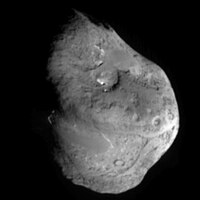
Photo from wikipedia
Abstract The Cometary Secondary Ion Mass Analyzer (COSIMA) onboard ESA’s Rosetta orbiter has revealed that dust particles in the coma of comet 67P/Churyumov-Gerasimenko are aggregates of small grains. We study… Click to show full abstract
Abstract The Cometary Secondary Ion Mass Analyzer (COSIMA) onboard ESA’s Rosetta orbiter has revealed that dust particles in the coma of comet 67P/Churyumov-Gerasimenko are aggregates of small grains. We study the morphological, elastic, and electric properties of dust aggregates in the coma of comet 67P/Churyumov-Gerasimenko using optical microscopic images taken by the COSIMA instrument. Dust aggregates in COSIMA images are well represented as fractals in harmony with morphological data from MIDAS (Micro-Imaging Dust Analysis System) and GIADA (Grain Impact Analyzer and Dust Accumulator) onboard Rosetta. COSIMA’s images, together with the data from the other Rosetta’s instruments such as MIDAS and GIADA do not contradict the so-called rainout growth of 10 μ m -sized particles in the solar nebula. The elastic and electric properties of dust aggregates measured by COSIMA suggest that the surface chemistry of cometary dust is well represented as carbonaceous matter rather than silicates or ices, consistent with the mass spectra, and that organic matter is to some extent carbonized by solar radiation, as inferred from optical and infrared observations of various comets. Electrostatic lofting of cometary dust by intense electric fields at the terminator of its parent comet is unlikely, unless the surface chemistry of the dust changes from a dielectric to a conductor. Our findings are not in conflict with our current understanding of comet formation and evolution, which begin with the accumulation of condensates in the solar nebula and follow with the formation of a dust mantle in the inner solar system.
Journal Title: Planetary and Space Science
Year Published: 2020
Link to full text (if available)
Share on Social Media: Sign Up to like & get
recommendations!